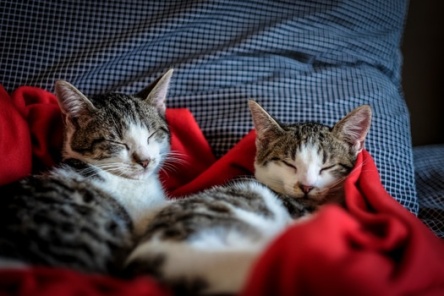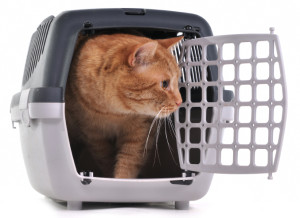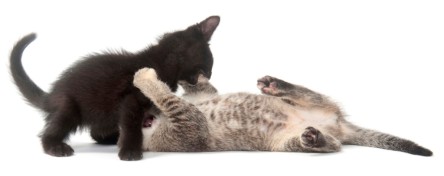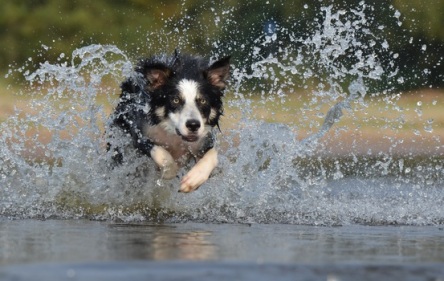
Don’t forget your pets also expect Santa’s visit this season!
TriCity Veterinary Hospital
37177 Fremont Blvd
Fremont, CA 94536
510-796-8387

Don’t forget your pets also expect Santa’s visit this season!
TriCity Veterinary Hospital
37177 Fremont Blvd
Fremont, CA 94536
510-796-8387
Dogs love to munch away on grass, and some even make it part of their daily routine. Fortunately, most experts believe it isn’t something you should worry about. So why exactly do they gobble up that green stuff in your yard?
Scavengers ‘R Us
Dogs, unlike their catty counterparts, are not carnivores. But they’re not like your garden-variety omnivores, either. For tens of thousands of years, these opportunistic scavengers have devoured anything and everything, as long as it fulfilled their basic dietary requirements.
The modern dog, partly because of evolution and domestication, is no longer like its ancestors, which frequently ate their prey entirely, including the stomach contents of plant-eating animals. Instead, dogs today seek out plants as an alternative food source. Most commonly the plant is grass — since that is what is closest at hand — but wild canines are known to eat fruits, berries, and other vegetable matter, too.
Clearly, dogs can find their nutrients in a wide range of plant foods, but that doesn’t explain why Fido usually throws up after eating grass.
When the Tummy’s Grumblin’
A dog will seek out a natural remedy for a gassy or upset stomach, and grass, it seems, may do the trick. When ingested, the grass blade tickles the throat and stomach lining; this sensation, in turn, may cause the dog to vomit, especially if the grass is gulped down rather than chewed.
Although dogs don’t typically graze on large amounts of grass like a cow, they may nibble on grass, chew on it for a while, and not throw up (an unwell dog will tend to gulp the grass down in big bites and then throw up). This may be because they find the texture of the grass palatable, or just because they need to add a little roughageto their diet.
Nutritional Necessity
Whatever the reason may be, most experts see no danger in letting your dog eat grass. In fact, grass contains essential nutrients that a dog might crave, especially if they’re on a commercial diet. If you notice that your dog has been munching away on grass or houseplants, then you may want to introduce natural herbs or cooked vegetables into their diet. Dogs aren’t finicky like cats, but they’re not too fond of raw veggies either. They’re kind of like big furry kids that way.
So, when you think about it, grass munching isn’t that bad at all. However, watch out for a sudden increase in grass eating; it could be a sign of a more serious underlying illness that your dog is trying to self treat, and that requires immediate veterinary assistance.
You may also want to buy a small tray of grass just for the dog, or start an herbal home garden. This will give your poor pooch an alternative to the outdoor grass and landscaping, the eating of which could lead to accidental ingestion of pesticides, herbicides, or chemicals that have been used to treat your (or your neighbor’s) yard.

Stress can make anyone a little crazy, even our cats. The tricky part is while the anxiety and fear associated with stress affects our cats in much the same way it does us, most cats tend to hide and mask their inner turmoil. Even worse, stress can be an indication that your cat has a health issue. According to Patricia B. McConnell, Ph.D., a certified applied animal behaviorist, chronic stress can even “suppress the immune response, causing a broad range of illnesses.” Here are some signs of stress you’ll want to watch out for in your cat, especially if they occur suddenly.
It’s annoying, smelly and a pain to clean up, but pay attention. Cats that urinate outside the litter box are trying to tell us something. Consult your veterinarian or a veterinary behaviorist to find out what it is.
This is another rather stinky situation and one that could be indicative of several things. Best not let it go and speak with your vet.
Cats are known for their fastidious grooming, but licking themselves raw or bald is a clear sign of distress. Skip the groomer and go straight for the vet’s office.
Like compulsive licking, excessive scratching can be indicative of several health and behavioral issues. Make an appointment with your veterinarian before the problem gets out of hand.
Aloofness is second nature to cats. However, a cat should not be actively and constantly hiding from you and everyone else in the house. Once you’ve managed to wrangle him or her into a cat carrier, go to the vet.
Many find the tone of a cat “talking” quite soothing, but be wary of unusually long or recurring bouts of panicked meows — especially if your cat is not the typical “talker.” If it does happen, take your cat to the veterinarian rather than try to crack the kitty language code.
Cats don’t go on fasts or diets like we do so it’s important to consult a veterinarian if your cat suddenly loses interest in food or stops eating altogether.
Just because cats can sleep up to 20 hours a day doesn’t necessarily mean your cat will. By now you will have become accustomed to his or her sleeping schedule. Speak with your veterinarian if you’re cat is sleeping more than usual or seems overly lethargic.
Fights or aggressive actions towards household pets or other animals can be a sign of a stressed or sick cat. Consult your veterinarian or a veterinary behaviorist before the problems gets worse.
A stressed or sick cat may also display aggression towards people, even you. Again, it’s best to consult your veterinarian or a veterinary behaviorist immediately.
Most people do not think about socializing cats or kittens. The whole behavior thinking process of a cat is different from a dog since they are mostly solitary. As household pets living with a family and exposed to all kinds of situations it is beneficial to give your cat the best and most interesting life you can. It will help if you expose your cat to many different things.

Instead of socializing, you could call the work you do with a cat “desensitization.” This means they are calm or cooperative in many new or different situations. As a cat parent you are probably saying it can’t be done. Yes cat training is possible and can start at a young age. In fact, most people have never bothered to work with their cats and believe all the old myths floating around about our finicky feline friends.
Some of the things to think about doing with your cat are: Traveling, teaching them to allow you to restrain them, brush them, check their eyes, ears, paws and teaching them what proper scratch items are! They can benefit by traveling around with you on errands, spending playtime on a leash in new areas, and being exposed to new people and animals in controlled environments. All this work will pay off as the kitten grows into a cat.
The more you involve your kitten in activities and interactions with others, the calmer they will be. The benefit is that they will be more likely to respond without fear or defensiveness as they grow older. Your Veterinarian and the Groomer will love you for it! Teaching your kitten right from wrong at an early age will prevent them from challenging you as they get older too. They will not necessarily like what it is you want them to do but they will more likely to cooperate if you have worked with them early in life.
Working with your cat should be done in short calm sessions. Brushing them is a good place to start with since it is so pleasurable. Next you can examine the ears by rubbing them. As you rub you can look in their ears, and touch different parts of the ear with your finger. This is great if you have to clean ears or medicate the cat later in life. GO SLOW! The biggest problem most people have is moving too fast with this type of work.
Holding the paws and gently applying pressure to extend the claws is another useful practice. You can do some amazing things with your cat if you take the time. Nail clipping, touching your cat all over, and other types of restraint will be easier if you work at it slowly. Later invite friends and neighbors to come over and visit. By socializing your cat to people they will be more calm around strangers later in life.
You can also help develop your cat’s intelligence by exposing them to lots of new things. A different amount of toys that are changed or rotated are a necessity. The most favorite toys can be pretty simple. Paper bags, the rings off of milk bottles, rolled up foil and other household items make great play items on a budget. They always seem to be the favorites over anything else too!
Teaching a cat to crate or enter a carrier is one of the more critical things to teach. Placing bedding in it or traveling with the cat in the carrier will get yourfeline comfortable with it.
 This is critical should the need for disaster evacuation, temporary housing during travel, and restraint be necessary. Many people have lost their cats because they were moving and did not think about securely putting their cat into a carrier or separate room for their safety.
This is critical should the need for disaster evacuation, temporary housing during travel, and restraint be necessary. Many people have lost their cats because they were moving and did not think about securely putting their cat into a carrier or separate room for their safety.
It does not matter if you get a pure bred kitten or rescue an alley cat since they all need the same loving care and guidance. Spend the time with your new family member and they will grow into a very secure and loving pet.
These suggestions and ideas will help show you what to do with your cat to make them happier, healthier, more secure and perhaps a bit more cooperative despite their independent nature.
This is an excellent way to get some natural Kitty aggression, stalking, pouncing and attacking directed into proper play. Also another important bonding experience with your furry friend. This will teach them to play in an appropriate manner.
We can take the cat out of the jungle, but we can’t take the jungle out of the cat. There is a little tiger in every house cat, a solitary predator that needs to exercise its hunting skills on a regular basis. We may have confined this little tiger within four walls, provided them with the finest of feline foods, but we can’t ignore their basic need to do that for which it was so perfectly designed – to HUNT. Fortunately, it is not always necessary for the prey to be alive, but it must move.
 Owners are often frightened by the playfully aggressiveness in cats and kittens because they look quite intense when they play. They silently ambush feet and ankles as they pass by surprising, upsetting, and sometimes, even hurting a family member. In some cases the cat owners have not intentionally trained their cat to be a feline terrorist by playing with it as a kitten with their hands or feet. The solution is to direct the cat’s playful, predatory, energies toward toys instead of moving hands or feet.
Owners are often frightened by the playfully aggressiveness in cats and kittens because they look quite intense when they play. They silently ambush feet and ankles as they pass by surprising, upsetting, and sometimes, even hurting a family member. In some cases the cat owners have not intentionally trained their cat to be a feline terrorist by playing with it as a kitten with their hands or feet. The solution is to direct the cat’s playful, predatory, energies toward toys instead of moving hands or feet.

Of course, the easiest solution, and perhaps the best, is to get another cat or kitten of the same sex and approximately the same age and activity level as a playmate for your them. Although you will now have two mouths to feed, the wear and tear on you and your home will be greatly reduced, or eliminated. If getting another pet is not possible, then it will be your responsibility to provide your playful cat with scheduled sessions of controlled play.

Schedule two or three (more, if necessary) interactive play sessions a day for times when Kitty is most rambunctious. Cats love routine, so try not to change the play times. Depending on how athletic your cat is, the sessions may last 10-20 minutes each, every cat and kitten will be different and require more or less time. A fishing pole type toy enables the pet parent to be stationary while controlling the cat’s activity level with a flip of your wrist. Some of the best commercially sold toys for this purpose are the “Da Bird” and the “Cat Charmer”. The play sessions should not stop until the cat is exhausted, lying on their side and batting at the toy because they are too tired to jump or chase after it.
During the play session make the toys move as wild prey-a little mouse or bird would. Don’t dangle the toy in the cat’s face. It should hide behind objects in the house and occasionally jump into the air. Build up Kitty’s confidence and enthusiasm by allowing plenty of “captures” and praise. After play fishing pole toys should be carefully stored out of the cat’s reach, if left out they could become entangled in the toy which could cause great harm and fear.

As kittens mature, the play patterns of male and females change. The rough-and-tumble, pounce-and-play sequence of male play behavior will continue and may not be appreciated by the female. When she is older he may be greeted with hisses and spitting, this is normal, she is simply telling him to slow down and back off. Both kittens and cats need these play sessions, it will keep them trim and very happy.
First of all, playful attacks are not bitting with hissing and growling. A natural reaction to being grabbed or bitten, even playfully, is to swat at the cat. Don’t do this! Physical punishment may cause your cat either to fear you or to engage in even more aggressive rough play, where they will think they are being attacked and challenged. If your cat becomes afraid of you, you may face a bigger problem – that of defensive aggression. If the attack can be anticipated, a blast of air from a compressed air can (obtained from any office supply store), a squirt from a water gun, or a shaker can (empty soda can with pennies in it) may discourage the behavior if produced at the moment of the attack. Timing is everything. If “used” a second or two after the incident, the means of distraction will not be connected with the attack in the cat’s mind and no training will take place, the cat will be frightened of you and confused. You can also carry a supply of soft toys to be given to the attacker, to redirect the play aggression from your skin to a toy.

Perhaps the best means of distraction is the one that is always at hand – one’s voice. A loud and shrill “Eek”, followed by a sharp “No!” can be very effective with some cats. You don’t need to YELL, just be firm with your voice and they will know there is something they have done wrong. The next step is to shun the cat for the next ten minutes. This means paying absolutely no attention to the cat. Don’t lecture or scold the cat and don’t pick them up to put them into a separate room. Any attention at this point can be reinforcing the bad behavior, so totally ignore the cat. This is precisely the way a kitten learns to inhibit his biting when playing with another kitten. If one becomes a little too rough, the victim will squeal and run away. The aggressor will watch his playmate run away and wonder what happened. Eventually he learns that if he wants to extend the play session (which he always wants to do), then he will have to be more gentle.
stalking. chasing, pouncing, batting, catching, throwing, fishing and communication
A cat needs to scratch on a surface so they can tone their nails and exercise their bodies. Providing them with a good scratching post designed to maximize your cat’s scratching pleasure and giving them an appealing target for territorial marking, exercise, and natural cat exuberance is very important.
The claws also allow the cat to grasp and hold objects as well as establish footing for walking, running, springing, climbing and stretching. By regularly trimming your cat’s nails and offering a suitable scratching target, you are providing a natural outlet for a normal, happy and healthy behavior and you will be rewarded with a satisfied and confident companion.
Think about it… If you had just brought home a new puppy and the puppy was digging up your expensive landscaping, scratching hardwood floors while running in the house, jumping on furniture and digging to find or hide a bone, would your first thought be to have your puppy’s claws and toes surgically removed? Your answer would be “NO”. I expect that you would naturally and intelligently start the puppy in a training program.
Trying to understand why people think so naturally to alter a cat’s behavior by removing the claws instead of suppling and training the cat to use a post versus something else inappropriate should be unheard of. Let’s give our cats their dignity by letting them keep the claws they were born with, so they can display their natural instincts.
Ok, so now let’s take a moment to understand just how important the cats claws are to them.
The cat is born with five retracting nails on each front foot and 4 nails on each rear foot which don’t retract (they remain exposed and don’t hide within the paw).

Dog lovers have no doubt noticed that smaller dogs live longer than large ones, and now there’s a scientific study to back that up, as well as a few hypothesis as to why this is true.
When compared to the lifespan of other mammals, “smaller size, longer life” would at first glance appear to be counter-intuitive, especially to families that have gone through short-lived pet rats (2 years), hamsters (3 years), or gerbils (4 years).
In the non-pet category, chimpanzees live shorter lives than humans — about 45 years vs. 70 years — and elephants have a lifespan comparable to humans. This is nothing, of course, compared to the bowhead whale. Weighing in at up to 65 tons and sixty feet long, current estimates place its maximum lifespan at 200 years.
Following this logic, then, we should expect a Great Dane to live longer than a Chihuahua, but that’s not the case. The former only live, on average, 6 or 8 years, while the latter can live up to 18 years.
As it turns out, while bigger species of mammals live longer than smaller ones, within species it’s reversed. While the following example may be anecdotal, it does indicate that even humans are subject to this rule; Wilt Chamberlain, the professional basketball player, was 7’1” tall and died at 63. Jerry Maren, the 4’3” actor best known as one of the Lollipop kids in the 1939 version of “The Wizard of Oz,” is still alive at 93.
The effect is even more pronounced in dogs, which have a more extreme range of sizes. According to the Guinness Book of World Records, the largest dog, a Great Dane named Zeus, was about as big as Wilt Chamberlain, measuring 7’ 4” feet in length and weighing 155 pounds. The smallest living dog is a Chihuahua named BooBoo, at 4 inches tall and 1.5 pounds.
For comparison, applying that size difference to the shortest verified human, 21 inch tall Chandra Bahadur Dangi, would give us a tallest human at about 31’ 5”. Going in the other direction, with 8’ 11” Robert Wadlow as the tallest human, the same size ratio would make the shortest human just barely under 6 inches tall. Incidentally, Chandra is still alive at 73, while Wadlow was only 22 when he died.
Recently, scientists tried to determine why this is the case. In a study led by Dr. Cornelia Kraus, a research scientist and lecturer at the University of Göttingen in Germany, researchers analyzed data on age of death in over 56,000 dogs from 74 different breeds, and were able to put a number on it. They found that, for every increase of 4.4 pounds of body weight, a dog’s lifespan decreased by 1 month.
The next step will be to determine why larger dogs live shorter lives, but the scientists already have some ideas. At its simplest, larger dogs die younger because they age more quickly. They age more quickly because they grow faster. This can lead to earlier incidence of tumors and other abnormal tissue developments, including cancer. It can also contribute to abnormal development, leading to physical conditions impacting health.

Ask most people how to determine a dog’s age in human years, and they’ll probably say, “Multiply by seven.” However, this method is inaccurate, and more so the older a dog gets. For a twelve year-old dog, the result could be off by over twenty years. Multiplying by seven only comes close while a dog is four and a half years old.
Dogs mature faster than humans, reaching the equivalent of twenty-one years in only two, but then aging slows to an average of four human years every year after. Dogs under thirty pounds live longest, often well into their teens; dogs over a hundred pounds have the shortest lifespans, being considered not just old but geriatric by six or seven.
So, next time someone asks you a dog’s age in human years, you’ll know how to give a more accurate answer. Subtract two from the age, multiply that by four and add twenty-one. After all, a forty-five year-old wouldn’t appreciate their spouse telling everyone that they’re fifty-six. You shouldn’t do the same to your eight year-old pooch.

We all want to keep our pets with us as long as possible, which is why we need to give them a certain level of care. Most dogs, depending on size, can live ten to fifteen years if they are in good shape mentally and physically. Here are some things that you can do to extend — and improve the quality of — your dog’s life.
1. Maintain your dog’s teeth: Tooth decay is a very common, yet dangerous health problem for dogs. This is because tooth decay not only creates dental problems, but it can cause infections throughout the body, especially in the heart and kidneys.
Most dogs are not going to have picture perfect teeth or fresh breath like a person, but their teeth and gums should be reasonably clean. You can buy a special kit to brush a dog’s teeth which includes a small brush and toothpaste. The best brush to use is double-headed with the brushes at a 45 degree angle to clean below the gumline, like those offered by Petosan.
Brush their teeth at least a couple of times every week to keep them clean, but never use human toothpaste, because it can be harmful to dogs. If your dog has a significant buildup of plaque, then you should visit a veterinarian to have it removed.
2. Keep your dog at a healthy weight: Unfortunately, the obesity crisis has affected animals as well as people. Dogs can become overweight if they eat a lot of fatty human foods, or even if they eat too much pet food and don’t get enough exercise.
One way to extend your pet’s life is to make an effort to keep them at a healthy weight at all times. Keep track of how much you feed your dog on a daily basis and keep them on a consistent schedule. Some fresh vegetables are okay for your dog to eat occasionally, or you can purchase organic pet food.
3. Give your dog regular exercise: Dogs need exercise in the same way that people do. Ideally, your dog should get at least an hour of exercise every day to improve their health and regulate their weight. The exercise does not need to be organized into a routine, but they should go outside and run or explore for a while, in addition to the several regular walks you take them on every day, of course.
You can also have your dogs play with other dogs during exercise time. Dogs tend to enjoy this, it helps them maintain a healthy weight. It can also keep them emotionally healthy as well.
Many of us know how to dog-proof our homes, but we often don’t take the same precautions when it comes to our outdoor spaces. Here’s how to protect your dog from backyard dangers.
Seasonal flowerbeds are beautiful, but many common flowers, including tulips, daffodils, azaleas and amaryllis can be poisonous to dogs. Talk to your vet about which plants are safe for dogs before you put on your gardening gloves.
Trash cans and recycling bins should be secured with appropriate lids Liquids such as fuel, cleaning supplies and antifreeze (which can be fatal to pets), need to be stored out of reach of your pet. Bug or rat bait and herbicides should be used with caution and stored properly, as they can also be fatal to dogs.
Even if your dog is a strong swimmer, he or she should never be left unattended in a yard with a pool. Your pool area should be fenced, and your dog should know how to safely enter and exit the pool from an early age.
Even if your yard has a fence, a wiggly pup can easily slip through tiny gaps or holes you may not notice. Regularly check the fence in your yard to make sure it is secure before letting your dog out in the yard.
Ticks will use tall grasses and branches in your yard to hitch a ride onto your dog’s skin. To help keep ticks at bay trim back high, tall grasses and remove debris.
Fleas tend to live in dark, humid areas like outdoor dog homes, decks and outdoor structures such as sheds. Sweep off patios, clean under your deck and remove debris from outdoor structures to prevent fleas from congregating in your yard.
Insecticides can help curb bug problems, but when applied heavily, may be toxic to pets. Try to avoid using insecticide when possible or talk to your veterinarian about the best way to use such chemicals. Keep your pet off lawns that have recently been treated with insecticides, pesticides or fertilizers.
Dogs love playing outdoors year-round, but dehydration and heat sickness can be a very real threat in warm, sunny weather. Make sure to give your pup plenty of breaks in the shade, access to fresh water and the ability to go inside if he needs it.